Why shouldn’t you miss the Sacred Valley when visiting Machu Picchu?
Travelers looking for experiences more than just crossing Machu Picchu off their bucket list should land in Cusco and head straight to the Sacred Valley of the Incas, an hour away and located between Cusco and Machu Picchu. This quiet stretch is set between mountains that resemble sleeping giants, tucked under an emerald blanket. But there are many reasons why you can’t miss the Sacred Valley when visiting Machu Picchu.
- Why should you go to the Sacred Valley if you are thinking of going to Machu Picchu?
- What is the Sacred Valley of the Incas?
- How to visit the Sacred Valley of the Incas?
- Cusco Tourist Ticket
- Places to see in the Sacred Valley of the Incas
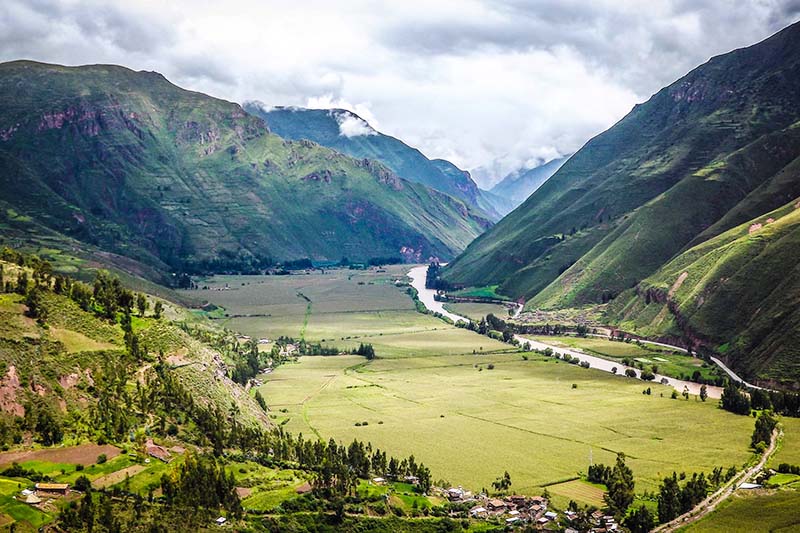
Beautiful view of the Sacred Valley of the Incas.
Many people make the mistake of taking day trips through the valley on the way to Machu Picchu, or overlooking it. However, the Sacred Valley offers a more authentic vision of the ancient Inca civilization and what they were able to build in places like Pisac, Ollantaytambo, Moray. Its 2,800 meters allow a gradual acclimatization, and omit the headaches that come included with the altitude in the city of Cusco; but we can teach you how to avoid altitude sickness on your trip to Machu Picchu.
On the other hand, new hotels, a craft brewery and fine restaurants, with some of the best chefs in the world, are placing the valley among the best destinations in South America.
Why should you go to the Sacred Valley if you are thinking of going to Machu Picchu?
Machu Picchu is one of the wonders of the world and one of the most amazing places on the planet, but it is only one of the many sites built by the Incas before the Spanish conquest led by Francisco Pizarro destroyed this magnificent civilization, which in less than 300 years became the largest empire in the western hemisphere, spanning from southern Colombia to northern Chile and Argentina, including Ecuador, Peru and Bolivia. And all this enormous empire was governed from the Sacred Valley of the Incas and the capital was Cusco.
If you visit Machu Picchu without visiting at least the best places in the Sacred Valley, you will be missing half of the story. Machu Picchu is the jewel of the Inca empire, hidden among the mountains, and the only way to reach it was to walk an Inca trail through the Sacred Valley of the Incas.
What is the Sacred Valley of the Incas?
The Sacred Valley is the valley formed by the Urubamba River (Vilcanota), was the nerve center of the Inca civilization and is currently one of the main destinations in South America. It is home to many colonial villages where you can see the daily life of the people of the Andes, ancient Inca cities abandoned almost intact, is the spiritual center in South America and one of the best places to practice adventure sports in Peru. But it is also an excellent place to buy traditional Andean textiles, handicrafts and other typical Andean objects, including gold and silver jewelry. If you don’t have enough time to tour the Sacred Valley as you should, be sure to at least see the sites of the towns of Pisac and Ollantaytambo.
How to visit the Sacred Valley of the Incas?
There are several places you have to visit in the Sacred Valley of the Incas, these provide a more holistic view of how great the Inca civilization was.
If you make the trip on your own, you can start in the town of Pisac, and from there visit the towns of the Sacred Valley. You can board a minivan from Cusco to Pisac in Puputi Street, it will cost you around 10 soles (US$ 3) to get there and between 5 and 10 (US$ 3) soles to move from one town to another in the valley, Urubamba, Ollantaytambo, Chincheros. From Urubamba you can go to the towns of Maras, Moray and Yucay. It is undoubtedly one of the best experiences you can have in Peru. Some people decide to go from Ollantaytambo to Machu Picchu, but for this you must have booked Machu Picchu tickets and train tickets in advance.
If you go on an organized tour hiring an agency in Cusco, you will go from Cusco to Pisac, then to Urubamba (including Maras and Moray), then to Ollantaytambo and finally to the town of Chincheros, returning to the city of Cusco. You can also choose to go from Ollantaytambo to Machu Picchu if you wish.
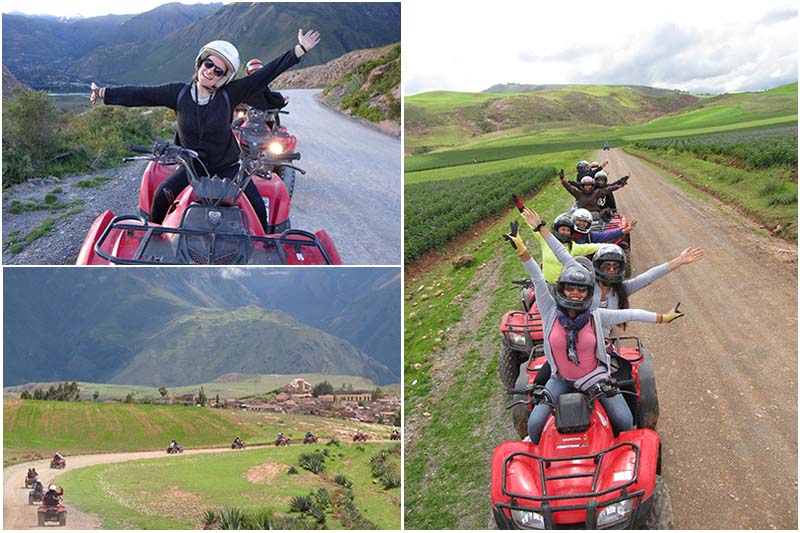
Tour of the Sacred Valley on ATVs
Cusco Tourist Ticket
To visit many of the best places in the Sacred Valley of the Incas you will need to buy the Cusco tourist ticket. You can buy a partial ticket if you only want to see the best places in the valley, or buy an integral ticket, which includes the best places in Cusco, the Sacred Valley and the South Valley. This ticket will have to be purchased in Cusco. It is a (not so convenient) large paper card (A4) with pictures of the places it includes. The “boleto turístico del Cusco integral” costs 130 soles, but as with the Machu Picchu tickets, you can get a discount if you have an ISIC card. These are the places where you can buy the Cusco tourist ticket:
- Cosituc main office: Galerías Turísticas, Av. Sol N° 103 (Monday to Friday 8 am to 5:30 pm and Saturday 8:30 am to 12:30 pm).
- Branch: Calle Garcilaso s/n (Monday to Saturday 8 am to 5 pm and Sunday 8 am to 8 pm).
In case of the Machu Picchu tickets, we recommend you to buy them before your arrival in Cusco, these are usually sold out weeks in advance; even more if you want the Machu Picchu + Huayna Picchu ticket, which has to be booked 4 months in advance. Here you can check the Machu Picchu tickets available.
Places to see in the Sacred Valley of the Incas
Ollantaytambo
With stone paved streets, stairways, arches and plazas, Ollantaytambo would be one of the best places to visit, even if you overlook some of the most impressive remains of the Inca Empire, however you cannot do this.
Ollantaytambo was a fortress, a kind of control center before accessing Machu Picchu, it has temples, ceremonial places, residences, and terraces. It is a mystery why they never completed the “Temple of the Sun”; it was previously thought that it was because the Spaniards arrived; however, now the possibility that Ollantaytambo was there before the arrival of the Incas is being considered. Perhaps this could explain why Ollantaytambo is aligned with other ancient sites on the planet; among them, the pyramids of Egypt, the Easter Islands in Chile, and others, belonging to the most important ancient cultures of the planet. Six kilometers from the citadel of Ollantaytambo you can see the quarry where the stones were extracted to build it, it is impressive because they had to divert the river into nearby canals to extract them from the same bed. You cannot miss the town of Ollantaytambo, even more, because you will have to get to this place to board the trains to Machu Picchu or to start the Inca Trail.
Pisac
The town of Pisac is famous for its world famous market, which is open every day, but the main fair is held on Sundays; here you can buy all kinds of handicrafts, alpaca garments, traditional jewelry (gold and silver) and fantastic Peruvian food.
On the slopes above the village of Pisac you will find extraordinary Inca constructions. This ancient Inca town has the best system of agricultural terraces achieved by the Incas in all the Andes; buildings finely assembled with stones fitted to perfection, residences, towers, military fortresses, astronomical observatories, etc.; highlights the Inca cemetery, the largest ancient cemetery in the Americas.
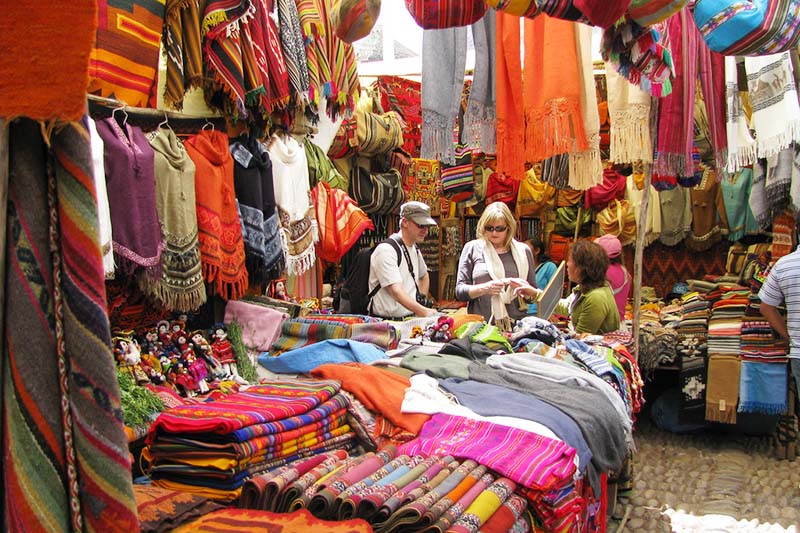
Tourists shopping at Pisac market
Urubamba
Although it seems a place relatively free of tourists; well it is true, that there are not many tourists, the “foreigners” that you will see in this place are mostly not visitors, but rather people who decided to change their countries to settle in this beautiful town in the Sacred Valley. It seems lost in time, people walk around without any hurry. This is a must for people looking for the best handicrafts of the valley and fine porcelain based on the Andean culture. From here you can visit the salt mines of Maras and the agricultural laboratory of the village of Moray.
The salt flats of Maras
A few minutes from the town of Urubamba you will find the town of Maras, where you can see the salt mines of Maras, where salt has been extracted since the time of the Incas and one of the four places in the world where you can extract pink salt. One of the most impressive views of the valley you will get from this mountain, where you will see more than 5,000 salt extraction ponds, the pools are fed by a salt water spring that the Incas diverted to flow through the salt mines. When the water evaporates, the salt crystallizes and is harvested. You can reach the salt mines of Maras by an unpaved road from the town of Urubamba, it is a winding road down the mountain slopes. A few stops along the way give you a perspective of the size of the Maras salt pans.
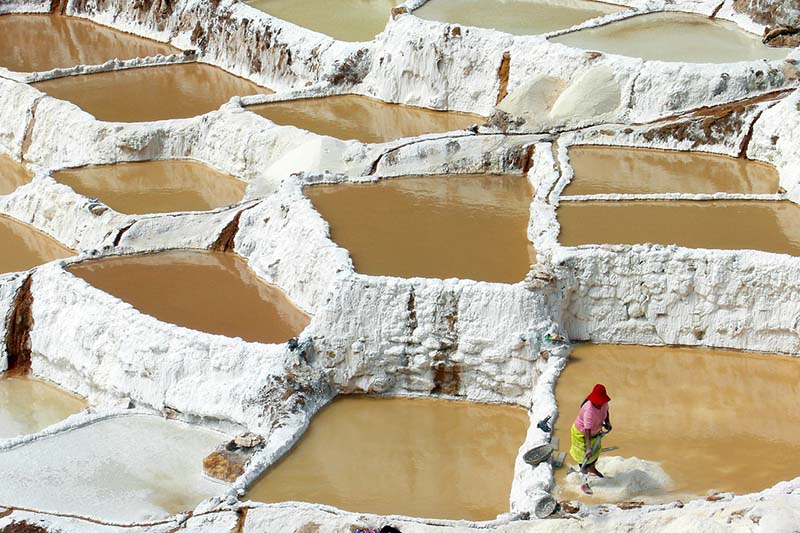
Woman extracting salt from one of the wells of the Maras salt mines
The Moray agricultural laboratory
You don’t have to be interested in agriculture or history to find the symmetrical circular terraces of Moray fascinating. The site is impressive, it is just outside the village of Moray, at first it looks like a giant green amphitheater, a wide bowl made up of layers and layers of flat terraces. There are actually two bowls in Moray, but one is much larger and better preserved than the other. Stone stairs built into the walls of the terraces allow access to the lower level. Each of the different terrace levels has its microclimate and is believed to have been used by the Incas as a kind of laboratory to experiment with the optimal growing conditions for their crops. With this information, the Incas were able to determine which areas were best for their various crops. Moray is not part of the usual Sacred Valley circuit, but we recommend adding it to your itinerary. The proximity to the salt mines of Maras means that you can visit both places.
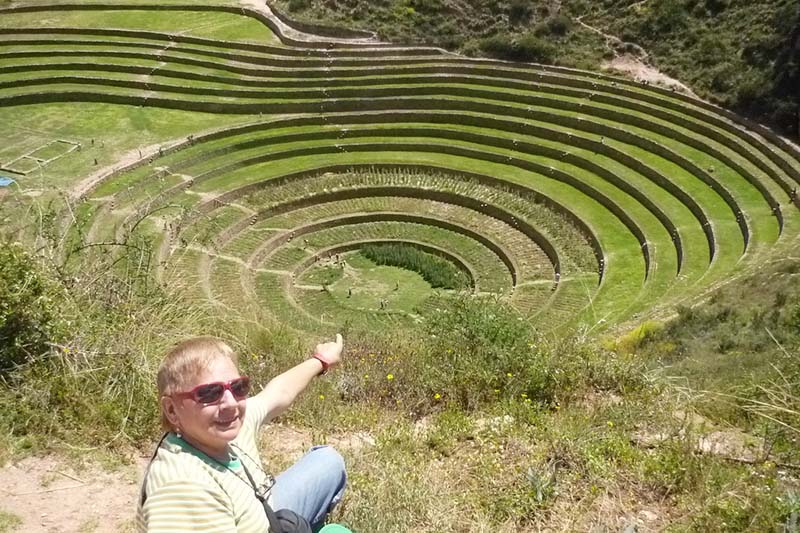
Agricultural research terraces located in Moray
Chinchero
It is much higher than the other towns in the valley, even the city of Cusco; the town of Chincheros is located at 3,800 meters above sea level. As you would expect, the views of the surrounding mountains from this location are spectacular; you will be able to see some of the valley’s snow-capped peaks. One of the best days to visit Chinchero is on a Sunday, you can visit the market, which although smaller than the one in Pisac, offers a more authentic experience, as in addition to finding beautiful handicrafts, you can barter and this is probably one of the few places in the world where you can do this. Also visit the main square and its 17th century colonial church.
Advice from people who have been there
 By: Laura H.
By: Laura H.“Impressive ruins“
“I can't explain the majesty of the valley, you have to experience it. You thought you could only see incredible constructions in Machu Picchu, you are wrong. What you can see in many parts of the valley will amaze you as much as the wonder.“
By Ticket Machu Picchu – Last updated, July 10, 2024